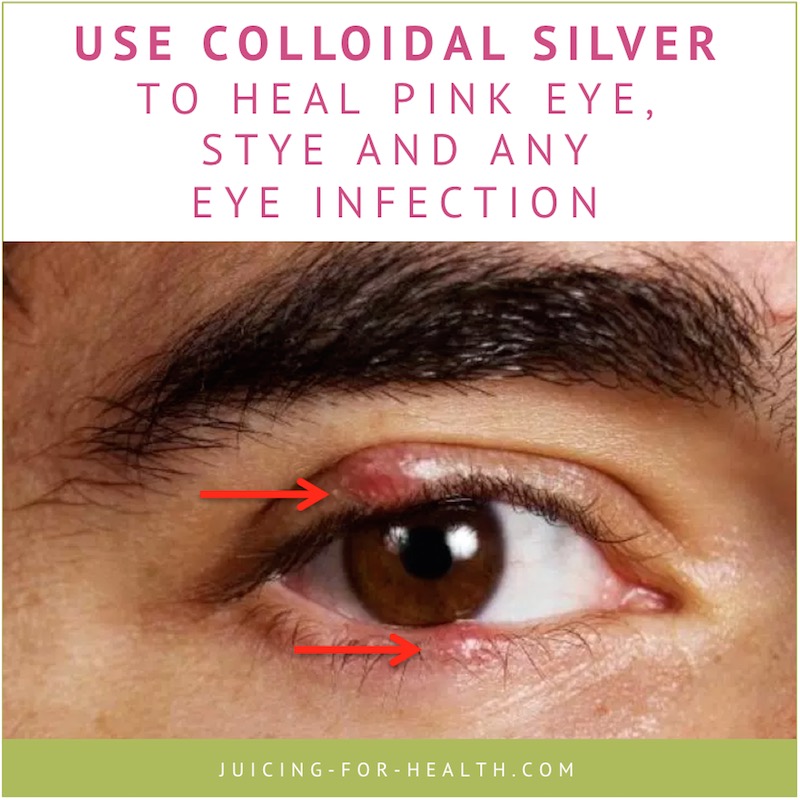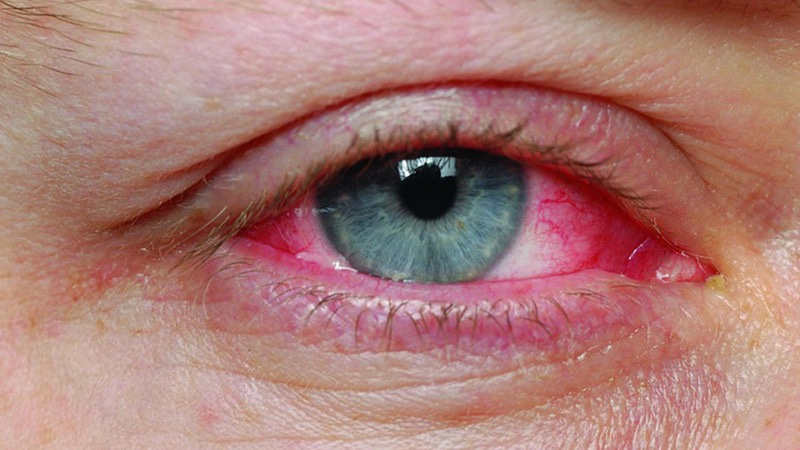How To Use Colloidal Silver To Heal Eye Infections Overnight!
Last updated on
Eye infections can be caused by bacteria, viruses, fungi, allergies or any other irritants that invade any part of the eyeball or its surrounding area. People who wear contact lenses are at a higher risk to eye infections due to the decreased oxygen reaching their corneas, and bacterial or fungal buildup when lenses are not properly cleaned and disinfected.
An eye infection can, more often than not, leave you with itchy, watery, swollen and red eyes. In more severe infections, there may be crusting and discharge.
When an eye infection invades the eye’s tear glands, it can result in an inflammatory condition and block the eye’s tear drainage. More serious eye infections, if left untreated, may lead to vision loss.
4 Common Eye Infections Caused By Bacteria Or Viruses
1. Conjunctivitis (a.k.a. Pink Eyes)
Conjunctivitis is an inflammation or swelling of the conjunctiva. The conjunctiva is the thin transparent layer of tissue that lines the inner surface of the eyelid and covers the white part of the eye.
Also known as “pink eye”, this eye infection can be viral or bacterial, or it may develop due to an allergic reaction to irritants such as pollen, smoke, chlorine in swimming pools, synthetic cosmetics, or contact lenses.
Pink eye is very commonly found among children and are highly contagious. It can spread easily through hand-to-eye contact by hands that have been in contact with the infectious virus. Viral conjunctivitis may even spread through sneezing and coughing.
Some of the symptoms of conjunctivitis are: Pink discoloration to the white in the eye(s), itching or burning sensation in the eye(s), excessive tearing, swollen eyelids, increased sensitivity to light and in more serious infections, discharge.
2. Keratitis (a.k.a. Corneal Infection)
Keratitis is the medical term for inflammation of the cornea. The cornea is the eye’s outermost lens that covers the iris, pupil and anterior chamber. It functions like a window that controls and focuses the entry of light into the eye, accounting for about two-thirds the eye’s total focusing power.
Staphylococci, or streptococci infections can occur when your eye comes into contact with contaminated objects, or when it’s caught from another infected person. These infections are painful and will cause eyes to become red and vision blurred. One may even go blind if the infection is left untreated.
3. Stye (A Bump On The Eyelid)
A stye (a.k.a. hordeolum) is a small, painful lump that grows on the inside or outside of the eyelid. Caused by the staphylococcus bacteria, this eye infection can last several days before it bursts and heals. Before that, a stye can be filled with pus and cause a red and painful swelling depending on its location.
4. Blepharitis
Blepharitis is an inflammation of the eyelids caused when oil glands located near the base of the eyelashes become clogged. This eye infection is often a chronic condition that can become uncomfortable. Fortunately, it is not contagious, and doesn’t cause permanent damage to your eyesight.
Some of the symptoms of blepharitis are: watery, red eyes, a burning or stinging sensation in the eyes, itchy eyelids, crusting, eyelid greasy and sticking, sensitivity to light and even loss of eyelashes.
Conventional Treatments Of Eye Infections
Many common eye infections will clear up on its own, but it usually take days, with a lot of pain and discomfort.
The medical profession will often treat an eye infection with prescription antibiotic eye drops, ointments or compresses. In some severe cases, an antiviral eye drop or steroid eye drops may also be prescribed.
According to an article on Drugs.com about a study on eye antibiotics:
“The study found that ongoing exposure to certain antibiotics (fluoroquinolones and azithromycin) was associated with the growth of drug-resistant bacteria, known as coagulase-negative staphylococci (CNS). Specifically, 81.8 percent of CNS samples taken from treated eyes appeared resistant to at least three antibiotics, and 67.5 percent appeared resistant to at least five antibiotics.”
That’s more than eight out of every 10 people tested—which is more than enough good reason to limit, as much as possible, the use of antibiotic drugs for preventing eye infections.
How about saving a trip to the doctor’s clinic, and avoid these harmful antibiotics and steroid eye drops?
How Can Colloidal Silver Heal Eye Infections?
Colloidal silver is powerful to curb any infection, yet it’s gentle on healthy cells. Colloidal silver destroys the cell wall of pathogens (harmful microbes) through catalytic oxidation.
It then enters the cell and binds with the pathogen’s DNA, stopping them from being able to replicate. Without replication, the infection is curbed and cannot spread.
According to Robert Young, author of The pH Miracle
According to Robert O. Young, PhD, author of the bestselling book The pH Miracle, colloidal silver works wonderfully for both eye and ear problems. He states:
“Eye or ear problems, including cataracts, glaucoma, redness, blurred vision, poor eyesight, ringing in the ears, earaches, soreness or swelling of the ears, eardrum damage, hardness of hearing, and (in rare cases) loss of hearing: Use 1 drop of colloidal silver topically (directly in the eye or ear) 3 times a day.”
How Effective Is Colloidal Silver For Eye Infections?
Depending on the severity of your eye infection, the proper use of colloidal silver could clear up the infection within a day or two. Many who have used colloidal silver for their eye infections or other infections were amazed and reported how quickly silver could stop the infections.
Read: 30+ ways to use colloidal silver for your health, pets and around the house.
How To Use Colloidal Silver To Heal Eye Infections?
With any of the eye infections mentioned above, you can use colloidal silver as an eye drop instead of prescription antibiotic eye drop. If you have an infection that is not mentioned above, there is no harm trying colloidal silver as it has been reported to heal any type of infection.
Put a couple drops of colloidal silver into each infected eye every hour. If it is a severe infection with discharge or pus, you may use a shot glass as an eyewash and fill it with some colloidal silver to clean your infected eye. Discard used silver and use fresh silver for the other eye. Do this every hour and see how fast the infection clears up!
If your eye infection is persistent, do the above drops/eyewash hour; and take one teaspoon of colloidal silver (or one dropperful) under the tongue, leave for 30 seconds and then swallow. Do this three times a day.
This is a safe brand that we trust and have received positive feedback: Sovereign Bio-Active Silver Hydrosol for Immune Support (10ppm).
Caution: Do not use castor oil in eyes if you have an eye infection.
What Is Colloidal Silver And Where Can You Get It?
Colloidal silver is a pure all-natural substance consisting of sub-microscopic clusters of silver, held in a suspension of pure ionized water by a tiny electric charge placed on each particle.
Colloidal silver is a powerful, natural antibiotic. It is the most usable form of the most effective disease, germ, virus and fungal killers known. It has been found to be both a remedy and a prevention for colds, flu, all infections and all fermentation due to any bacteria, fungus or virus, especially staph, and strep, which are often found in disease conditions.
It has been reported to rapidly subdue inflammation and promote faster healing. The body needs colloidal silver to fight disease-causing organisms and to aid healing. Taken daily, colloidal silver provides a second immune system resulting in more energy, vitality, vigour, relaxation, faster healing and reduced bodily toxins.
A prescription antibiotic kills on average, 6 different disease organisms, but colloidal silver is known to kill over 650 diseases without any harmful side effects or toxicity.
Recommended TRUE Colloidal Silver

Due to their tiny size and even distribution throughout the liquid, true colloidal silver is very safe to take and is believed to never cause argyria (blue skin pigmentation).
How can you be sure you’re taking true colloidal silver?
This is a particularly safe brand that we trust and have received positive feedback: Sovereign Bio-Active Silver Hydrosol for Immune Support (10ppm).
Read more about the health benefits of colloidal silver.
Some of the links I post on this site are affiliate links. If you go through them to make a purchase, I will earn a small commission (at no additional cost to you). However, note that I’m recommending these products because of their quality and that I have good experience using them, not because of the commission to be made.



































 JOIN OVER
JOIN OVER
Comments